|
Exiles, Escapees and Emigrés - a look at Buenos Aires Zero Degree
Buenos Aires Zero Degree is the name given to a special documentary made by Amos Lee and Kwan Pun Leung, following the making of Wong Kar Wai’s groundbreaking Happy Together. The documentary is one of the few intimate and privileged pieces about the making of a WKW film, and many fans consider it crucial viewing even if it is not strictly part of the WKW canon.
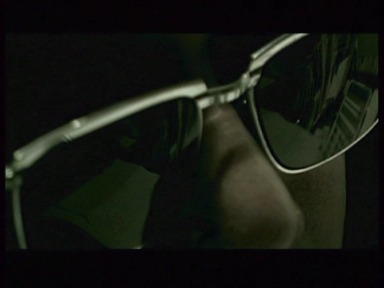 |
| WKW gives Amos Lee and Kwan Pun Leung close up access to the making of Happy Together. The exercise of taking a major project to the other side of the Earth, without a script or schedule, was always sure to be interesting - and the documentary gives an intimate chronicle of this unique project. |
It is, however, very much part of the WKW phenomenon. By the time Happy Together was being made, WKW's reputation for unorthodox, unplanned and impressionistic methods was clear. The pitch for Happy Together - simply to dump two major Hong Kong stars in Argentina to let WKW figure out a movie - is so outlandish by Hong Kong's capital driven standards that the whole project was out on a limb, artistically and financially. This documentary provides some insight into how the idea eventually turned into a film.
The documentary starts with an almost classic snatch of WKW interview dialogue. Indeed, he and Tony Leung form the main ‘star’ interviewees (perhaps Leslie Cheung’s unavailability and public friction with WKW after this film explains his absence from interviews) and both make lucid and interesting points throughout the piece’s one hour runtime. WKW comments on how his fandom of Diego Maradona drew him to Argentina, and he thought he would go there to make a film at least as a pilgrimage. On the one hand the words are taken with a pinch of salt, as many fans will realise how WKW in interviews (when he absolutely will never remove his iconic sunglasses) loves toying with occasional digressions or deliberately pat answers.
On the other hand, what we see on screen is footage of Maradona passing by a stream of fans, one of whom is Tony Leung, in character. What is being revealed to us is a glimpse of what didn’t make the final cut. The opportunity to see the missing segments - all the possible Happy Togethers - is one of the core attractions of BAZD.
What the documentary also provides is a viewpoint on the formation of the film; the great and occasionally exasperating lengths WKW and his team went to on the extremely uncertain creation of a movie. The documentary provides a closer focus on two members of crew too: the scene shifts to video footage of Leticia Yeh, the production secretary who worked on the film, touring the offices where the crew set up in mid-1996. Leticia forms one of the main ‘non-star’ interviewees, along with Aili Chen (continuity), and the documentary follows their experiences just as closely as those of the stars.
And both Leticia and Aili are emigrants from Asia. The atypical nature of WKW’s approach to overseas and location shooting meant that, though he brought as much of his crew over as possible (or his ‘circus’, as he puts it), the difficulties and spiralling costs associated with the shoot required local crew, and it was a natural step that bilingual Chinese immigrants (immigrants from the Argentine viewpoint) would form a vital part of the team too. In some ways, the documentary is filling the gap left by Happy Together - when the film was released many critics had expected more of a focus on immigrants rather than the traveller/tourists who made it to the final cut. In BAZD we have not only a glimpse of missing subplots and missing characters, but also it brings us to the reality of immigrant crew members who have their own stories.
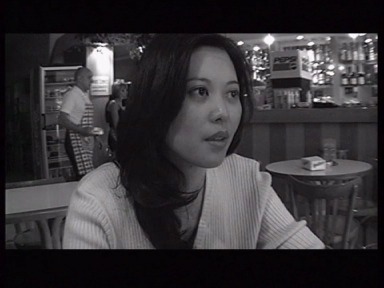 |
| One of the Argentine-Chinese crew members is Leticia Yeh, and her experiences show the complexity of an international project, as well as hinting at the complex identity of someone who is'Chinese overseas' by culture. |
After some video footage of the crew in initially high spirits, and the two leads learning to tango, we delve into how the shoot developed. With Aili Chen, we revisit the site of the apartment which features heavily in the film. This is intercut with sequences, some from the final edit, showing how Tony and Leslie’s characters become increasingly trapped in the oppressive atmosphere of stasis - Tony’s insecurity and Leslie’s growing anger bringing the situation to a violent head. Even more so than in the final cut, a sense of desperation pervades these sequences, culminating in a melodramatic suicide attempt by Tony.
We leave the insularity of the pair’s dysfunction and alight on a new character who didn’t make the final cut. Intriguingly, Mrs Siu appears to be a non-actor who, after filming completed, returned to run the restaurant shown in the documentary. Her role is of a nurse, whose path crosses with both Leslie and Tony. As she explains, WKW said (in as direct an explanation of motivation as WKW will ever make) her character was to portray envy of Leslie for Tony. Whilst this crush is portrayed on one level, we see a nurturing character who may also be read as a surrogate mother; revisiting a theme WKW worked on in Days of Being Wild.
Further unused footage also shows a fascinating identity swap which the two central characters engage in. All WKW’s concerns about identity and signifiers of identity seem to be distilled in Tony’s monologue - to possess the increasingly unattainable Leslie, to make sure his memory is retained - the scene (perhaps a little clumsily) encapsulates many of the ideas which WKW hinted at in his earlier works.
‘You will remember those three words, Ho Po-Wing,’ says a near-comatose Tony. Those three words - as undefined as they were in Ashes of Time - a name this time, but just as easily a declaration of undying love, undying memory. Just as Karen Mok’s crazed ‘Baby’, from Fallen Angels, so fears being forgotten that she will bite a man as a souvenir, the idea of a leaving a memory, even by proxy, is an ongoing concern for WKW’s characters.
A desire to leave a memory is one thing, but a desire to leave Argentina with a film was what plagued WKW and the crew. Not happy with the depressive direction which the story had gone (Tony’s character committing suicide successfully in one strand), WKW sought other avenues out. The problems were exacerbated by reports of profiteering by local fixers, and even death threats from extortionists. Finally, Leslie Cheung tired of WKW’s dilated methods and, with the onset of his busy concert schedule, he left Argentina.
Eventually, the character of Mrs Siu was cut out. Perhaps the reportedly acrimonious exit of Leslie required a ‘new start’, and this may explain the absence of Mrs Siu from the final cut. A shame, but an understandable one. This new start manifests itself in two forms. One is of the Central Restaurant - a Chinese restaurant which seems to have tweaked the crew’s sense of growing homesickness. Indeed, WKW’s story of how he discovered the place - whilst seeking out an acupuncturist to treat a sudden apoplectic episode - seems fantastically serendipitous. The restaurant’s mixture of friendly denizens is portrayed in the documentary almost like an extended family for the weary travellers of WKW’s crew. The idea of family, of belonging, so tenuous in the WKW world, emerges to support the production and boost morale.
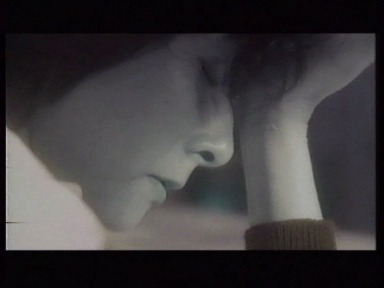 |
| The character of Mrs Siu could have been one of WKW's most interesting forays into using non-professional actors. Her hinted at role would have brought more focus on the pseudo-maternal theme first portrayed in Days of Being Wild. |
And the second form of a new start emerges with a new actor. Chang Chen has, WKW says, qualities that remind him of a younger Leslie Cheung. However, he has a different dynamic, a different energy. In fact, his carefree brightness brings to mind an alternative Takeshi Kaneshiro. We see Chen wandering around the streets of Buenos Aires, his cassette recorder sucking in the sounds of this bustling city. Where Tony and Leslie find their tourist/self-discovery journeys stymied into mutual self-destruction, Chen is enjoying this ‘other’ town and the sights (and sounds) it offers.
As the final edit of Happy Together portrays, Chen interfaces with Tony’s story as a co-worker who befriends him. Where the carefree Chen and the increasingly morose Tony share ground is unclear, yet the film portrays touching moments of connection. Seeing BAZD, perhaps it becomes even clearer how these meaningful moments are highly subjective. Drunken and incapable, Tony is escorted back to his apartment by Chen. Thinking Tony is unconscious, Chen tries some of Leslie’s clothes from a wardrobe, putting on one of Leslie’s jackets. For Tony, this signals a nexus he has with this ‘alternative’: this is the carefree Leslie who has not become Tony’s enemy, his tormentor. Unlike Leslie, he won’t say ‘let’s start over’.
Well, Tony and Chen have not really started at all. This is the classic juncture of the WKW story - is there a relationship? Is anything requited? The documentary gives extra information here by showing us more of Chen’s story - making clear his position outside of Tony’s imagination, beyond the template of Tony’s infatuation. Even more so than in the final edit, the unused footage highlights Chen’s independence - how he forges his own path.
This path takes Chen to ‘the end of the world’. It is a path taken by the cast and crew too, as WKW is shown travelling until he can go no further. This desire for motion, reflected in the second half of Happy Together, is a manifestation of WKW’s response to the stasis which his film had settled into. And once he reaches the end of the world, he realises that the characters must make the move back rather than remaining in a ‘place where times stands still’. Chen is not an emigrant - he will be going home.
As will Tony. In the final edit, Tony’s homecoming is a crucial part of the second half of Happy Together, greatly affecting the tone of the film. But from the unused footage we glimpse another character who doesn’t make the journey home; a character who was eventually excised in her entirety - Shirley Kwan.
Shirley Kwan’s character is probably the most important and high profile not to make the final cut. A singer in real life, Shirley had already contributed to a WKW film with her cover of ‘Forget Him’ playing a pivotal role in Fallen Angels. From BAZD we can see that her character would have been a traveller who crosses paths with both Chen and Tony. With Chen, we see her and him winding through the Buenos Aires night in separate taxis, a motorised tango and the wind in their hair. Shirley, languishing in the drunken/stoned state of WKW’s most mysterious femmes, is singing a song whilst Chen, his tape recorder outstretched, is trying to capture her voice.
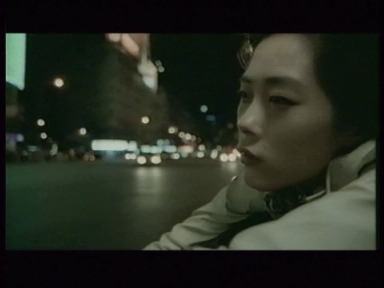 |
| Shirley Kwan's lonely, mysterious character seems like an amalgam of several earlier WKW femmes. On an entertainment level the combination of her star status and the contribution of her singing (she sings a cover of 'Cucurrucucu Paloma') would have somewhat altered the film. Alongside Faye Wong, she would have been one of the very few WKW actresses to sing in their own films. |
With Tony, we see her asking to borrow some change off him. She is playing on amusement arcades, making telephone calls, passing time. We hear his voice, his curiosity - ‘are you Chinese?’ They share time on the amusements. Yet Tony is still looking sullen. Shirley’s friendly gestures illicit very little from Tony. She knows Tony may visit the famous Iguazu Falls. They part.
There has been speculation as to why Shirley’s character was cut. Some read the absence as an attempt to keep the focus on homosexual relationships (or male platonic relationships, in Tony and Chen’s case), whilst the film’s running length would undoubtedly have been significantly longer had the whole of Shirley’s segment remained. More interestingly, one can see her character as an example of an iteration which WKW went through whilst making Happy Together, which the final edit evolved beyond. WKW’s films are self-reflexive developments of each other (something which frustrates his critics), but with Shirley Kwan’s character we have an example of a meta-stage which wasn’t quite the final product, but is a fascinating amalgam of earlier ideas.
For example, with Chang Chen, Shirley’s mysterious persona closely resembles that of Michelle Reis in Fallen Angels and Brigitte Lin in Chungking Express. This is most apparent when Chen meets her on a train and assails her with questions - here the Takeshi/Brigitte comparison is strongest. Then, with Tony her persona is markedly different - she becomes the bright, energetic force of Faye Wong in Chungking Express, or one of the two pixie-ish spirits in Fallen Angels, Karen Mok and Charlie Yeung. Indeed, jumping from amusements to telephones, her request to borrow small change is taken directly from Fallen Angels’ Charlie Yeung.
The tension, as ever, is defining whether there is a relationship, and what it is. As far back as Days of Being Wild, we have Maggie Cheung prolonging her conversation with Andy Lau by borrowing change for a bus fare. An entirely practical concern which defines the start of an interaction. But does this practical, indeed commercial interaction define the relationship and negate anything else? ‘Are you Chinese?’ asks Tony to Shirley - this may not be a commercial context, but the question is equally practical, just as impersonal. These complexities are borne out in that we know Tony’s backstory - with the resultant possibility that he may not requite Shirley’s love.
Does Shirley love Tony? Any notion of clear communication is avoided (‘hold me... to make them jealous...’), but the final idea that WKW envisaged - that Shirley would go to Iguazu Falls and find a job, in the hope that Tony might pass by, harks back to Andy’s dilemma with Maggie in Days (on his beat he would stop by at a telephone box on the chance that Maggie might call).
WKW may have been hoping to create something as disjunctive as Days - we know that Tony does visit the falls, although we have no indication as to whether Shirley was working there at the time. Even a scene with the both of them drenched beneath the falling waters is dreamlike and suggestive - made to seem like super 8 footage projected on a less than perfect screen and re-shot. WKW’s vision for Tony’s visit to the falls is not clear - ‘we don’t know whether he lives or dies,’ explains the director.
And to add to this disjunction we have Chang Chen. His approach to Shirley is far more straightforward, but it brings no reciprocation. The idea of this delicious web of connections is quite fascinating. Tony, smarting from the experience of Leslie, may pine for Leslie or he may be in an unrequited infatuation with Chen. Chen, ignorant of this, finds himself fascinated by the mysterious figure and voice of Shirley. Shirley shows all the signs that she is infatuated with Tony, even though he shows no sign of requiting this. Maybe Argentina is a smaller place than it looks.
But in the end, Shirley’s character was cut out. In a way, WKW avoided making a further iteration of Days, and ended up with a leaner film. The final product won fans at film festivals all over the world, with many critics claiming that it signalled WKW’s entry into the top echelons of world cinema, art film, or whatever moniker is used to separate one market from another. The question always floats around as to whether Happy Together would have been a ‘better’ film with the Shirley Kwan sequence in. There is no clear answer. All that can be said is the BAZD gives the viewer an opportunity to see what could have been.
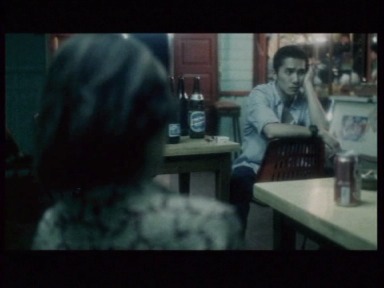 |
| WKW's vision for Shirley Kwan appears split between the fascination Chang Chen has for her, and the apparently unrequited feelings she has for Tony. Ironically, WKW envisioned that her story would end at Iguazu Falls - the locus of Tony and Leslie's idealised relationship. Awaiting Tony indefinitely she continues this theme: the same locus, another idealised destination. |
With the Shirley Kwan sequence in, the tone of the second half may have been markedly different. Tony’s journey home would have become - in the expectations of us, the audience - less crucial than a potential connection with Shirley, whose outlook seems better rooted in Argentina. Furthermore, Chen’s character would have become somewhat less carefree, as his fascination with Shirley would have marked a more sober, adult dilemma.
Some of these issues are reflected in the lives of the contributors to BAZD - Leticia Yeh explains how, after filming ended, she felt compelled to return to Taiwan (although the start of the documentary reveals that she returned to Argentina afterwards). Aili Chen seems almost to typify the Wong-ian wanderer - she is keen to be away and independent of others. As an emigrant she can find and test her strength.
And maybe that’s what Happy Together as a filmmaking process was about. As WKW explains, prior to making the film he couldn’t separate film from life, and only afterwards could this process begin. On the way, he took his ‘circus’ to the end of the earth, almost as a test of how far he could go. Everyone was pushed to their limits, from Tony reportedly being tricked into his role, to Leslie having his priorities put on trial. That WKW and his team came out the other side, complete with a film, is quite an achievement.
What happened at the editing stage - when Happy Together became a story of temporary exiles and escapees, with less attention given to permanent emigrants - is beyond the scope of BAZD, however. We can only speculate as to what ideas WKW and his team felt were vital, and at least BAZD gives us a glimpse of what just didn’t make the final edit.
There is no doubt that BAZD is highly recommended viewing for any WKW fan. Amos Lee and Kwan Pun Leung have done a good job of piecing the documentary together. It has been commented that BAZD’s coherence is somewhat loose, but perhaps that is the key to making a WKW documentary. For instance, with many documentary filmmakers every snatch of interview footage with WKW would have been scrutinised for meaning, and stood up against some form of observed evidence, or against some kind of hypothesis.
But Kwan and Amos take an approach which is less concerned with theories than with bringing us a sense of the ordeal and inspiration which goes into making a film. Whilst it is still possible to quibble that the documentary doesn’t dig into WKW as deeply as one might think possible (his myriad gnomic musings, such as the final intertitle about the meaning of exile, or his starting opinion that ‘actually, the film is very close’ to the Argentines are left nicely cryptic), the documentary does well not to ruin the mood with extraneous analysis.
With much of the documentary made up of Happy Together’s unused footage, the question has to be asked as to how much of the footage was edited by WKW’s team, and how much of the editing was extrapolated by Amos Lee and Kwan Pun Leung. Rumours of a super-extended version of Happy Together - with a runtime at least one hour longer than the final film - have floated around since 1997. Therefore, the edited segments featured in BAZD may indeed be in the form WKW envisaged. At least to an extent. The documentary slips seamlessly between the unused Happy Together footage and video shot by Amos and Pun Leung, and the documentary makers have clearly had some licence as far as juxtaposition of scenes and soundtrack are concerned. Whoever takes the primary credit for editing the sub-sequences from this alternative Happy Together, the feel of the film is consistent and the impact of the footage is not wasted.
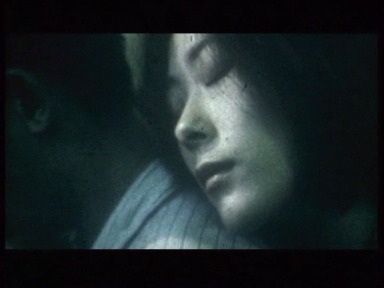 |
| Moments of intimacy, real or imaginary, direct or elliptical - these drive all the best WKW films foward. BAZD has no shortage of these moments. Perhaps that is part of the documentary's charm: to make you imagine this parallel Happy Together - as illusory as it is 'perfect'... |
So, BAZD is highly recommended viewing for any fan of Happy Together. It’s not a documentary in the sense that it finds an answer or pushes a viewpoint. Rather - in the best WKW tradition - it provides a sense, a feeling, of an experience and a consciousness. For those not familiar with WKW’s tortuous process, it shows just how difficult, and even counter-intuitive it can be to work with WKW. The remoteness of the location to the crew comes through clearly in this documentary, but it also gives us a viewpoint on those who have come to Argentina and made it their home.
And perhaps the final shot from the window of the aeroplane visualises this dichotomy - whatever distance we are separated by physically can be bridged, can be overcome. Isn’t it ironic that Shirley would choose to take up a job by Iguazu Falls, merely on the off chance that Tony might pass through? It’s all the more ironic as her job involves answering a telephone - that item which potentially connects her to everyone and everywhere. But there is something in the raw physical idea of proximity and distance which emphasises the importance of space: we feel Tony’s remoteness, even if he is never more than a telephone call away from ending his exile. And it is this sense of space which pulled the crew to their extremes, before WKW decided to make his story head home.
BAZD is not just a valuable behind-the-scenes look at the making of a WKW film, or even just a collection of deleted scenes. Rather, it is also a wonderful journey itself. For the fan, it provides plenty of food for the imagination and more than a few memorable moments. Personally, I would love to see something similar for 2046. Kwan Pun Leung actually went on to co-shoot 2046, so perhaps he’s still sneaking around the offices at Jet Tone Studios trying to scoop up more unused footage. Well, we can live in hope.
|